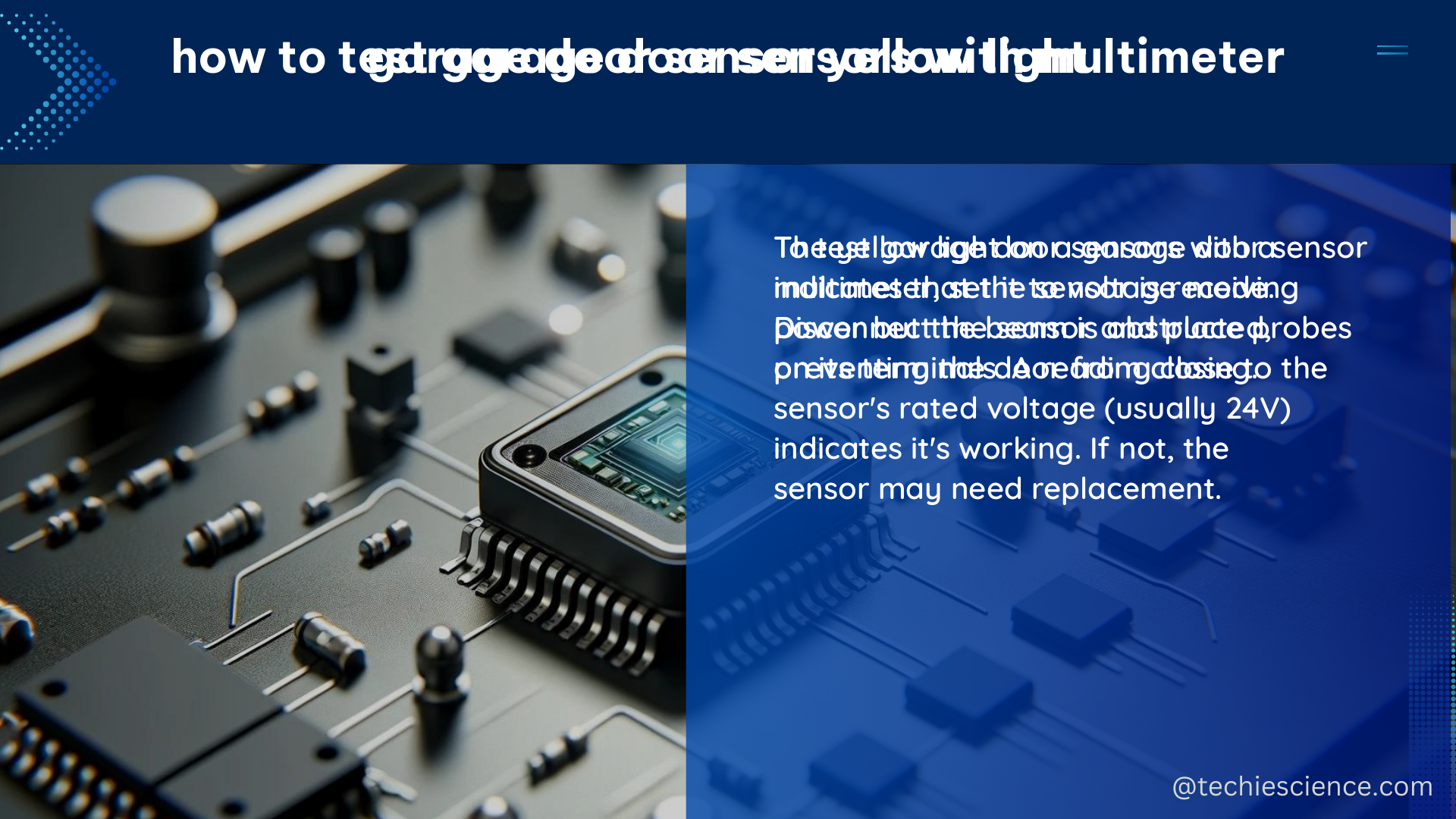The garage door sensor yellow light is a crucial component of a garage door system, indicating the status of the door and any potential issues. This comprehensive guide delves into the technical details of the yellow light sensor, providing a wealth of information for DIY enthusiasts and professionals alike.
Understanding Garage Door Sensor Technology
Garage door sensors often utilize a variety of technologies to detect the presence of objects and monitor the door’s status. These include:
-
Balanced Magnetic Switches: These sensors use a pair of magnets to detect the position of the garage door. When the door is closed, the magnets are aligned, and the switch is closed, indicating a closed door. When the door is open, the magnets are separated, and the switch is open, signaling an open door.
-
Glass-Break Sensors: These sensors are designed to detect the sound of breaking glass, which can indicate an attempted break-in. They are often used in conjunction with other security measures to enhance the overall protection of the garage.
-
Passive Infrared (PIR) Sensors: PIR sensors detect the heat signature of moving objects, such as a person or animal, within the sensor’s field of view. This can be used to trigger the yellow light or other alarm systems when an intruder is detected.
-
Interior Monostatic Microwave Sensors: These sensors emit and detect microwave signals, which can be used to detect motion within the garage. They are often used in combination with other sensors to provide a more comprehensive security solution.
-
Video Motion Detectors: These sensors use video cameras to detect movement within the garage. They can be programmed to trigger the yellow light or other actions when motion is detected.
-
Dual Technology Sensors: Some garage door sensors combine two or more of the above technologies, such as PIR and microwave sensors, to provide more reliable and accurate detection.
Measuring Sensor Performance

Evaluating the performance of garage door sensors is crucial for ensuring reliable operation and identifying areas for improvement. Key performance metrics to consider include:
-
Detection Range: The maximum distance at which the sensor can reliably detect objects or motion. This is typically measured in feet or meters.
-
Detection Angle: The angle or field of view within which the sensor can detect objects or motion. This is often expressed in degrees.
-
Response Time: The time it takes for the sensor to detect an event and trigger the yellow light or other actions. This is typically measured in milliseconds or seconds.
-
False Alarm Rate: The frequency with which the sensor generates false alarms, which can be caused by environmental factors or improper installation.
-
Reliability: The consistency with which the sensor accurately detects events and triggers the appropriate actions.
Integrating Garage Door Sensors with Smart Home Systems
Garage door sensors are increasingly being integrated with smart home systems, allowing for advanced monitoring and control. Some key features and capabilities of these integrated systems include:
-
Remote Monitoring: Homeowners can monitor the status of their garage door, including the yellow light, from anywhere using a smartphone or other connected device.
-
Automated Actions: Smart home systems can be programmed to automatically trigger the yellow light, close the garage door, or take other actions based on sensor data or user preferences.
-
Predictive Maintenance: Sensor data can be used to identify potential issues with the garage door system, allowing for proactive maintenance and preventing unexpected breakdowns.
-
Energy Efficiency: Smart home systems can optimize the operation of the garage door and related systems to improve energy efficiency and reduce utility costs.
-
Enhanced Security: Integrated sensor data can be used to enhance the overall security of the home, with the yellow light serving as a visual indicator of potential threats.
Troubleshooting Garage Door Sensor Yellow Light Issues
If the yellow light on your garage door sensor is not functioning as expected, there are several steps you can take to troubleshoot the issue:
-
Check Sensor Alignment: Ensure that the sensor is properly aligned with the corresponding component on the other side of the garage door. Misalignment can cause the sensor to malfunction and trigger the yellow light.
-
Inspect Sensor Connections: Verify that the sensor is properly connected to the garage door control unit. Check for any loose or damaged wiring that may be causing the yellow light to malfunction.
-
Test Sensor Functionality: Use a multimeter or other diagnostic tool to test the sensor’s functionality. This can help identify any issues with the sensor itself, such as a faulty component or a power supply problem.
-
Clean Sensor Surfaces: Dust, debris, or other obstructions on the sensor’s surface can interfere with its operation and trigger the yellow light. Gently clean the sensor’s surface using a soft, dry cloth.
-
Update Sensor Firmware: If available, check for any firmware updates for your garage door sensor. Updating the firmware can address known issues and improve the sensor’s performance.
-
Consult the Manufacturer: If you are unable to resolve the issue, refer to the manufacturer’s troubleshooting guide or contact their customer support for further assistance.
By understanding the technical details of the garage door sensor yellow light and following these troubleshooting steps, you can ensure the reliable and efficient operation of your garage door system.
References:
- ADS Glossary | USAID: https://www.usaid.gov/sites/default/files/2022-05/ADS_Glossary.pdf
- Effective Physical Security – NIBM E-Library Portal: https://nibmehub.com/opac-service/pdf/read/Effective%20Physical%20Security%20by%20Fennelly-%20L.J.%205ed.pdf
- Transit Signal Priority (TSP): A Planning and Implementation Handbook: https://nacto.org/docs/usdg/transit_signal_priority_handbook_smith.pdf

The lambdageeks.com Core SME Team is a group of experienced subject matter experts from diverse scientific and technical fields including Physics, Chemistry, Technology,Electronics & Electrical Engineering, Automotive, Mechanical Engineering. Our team collaborates to create high-quality, well-researched articles on a wide range of science and technology topics for the lambdageeks.com website.
All Our Senior SME are having more than 7 Years of experience in the respective fields . They are either Working Industry Professionals or assocaited With different Universities. Refer Our Authors Page to get to know About our Core SMEs.